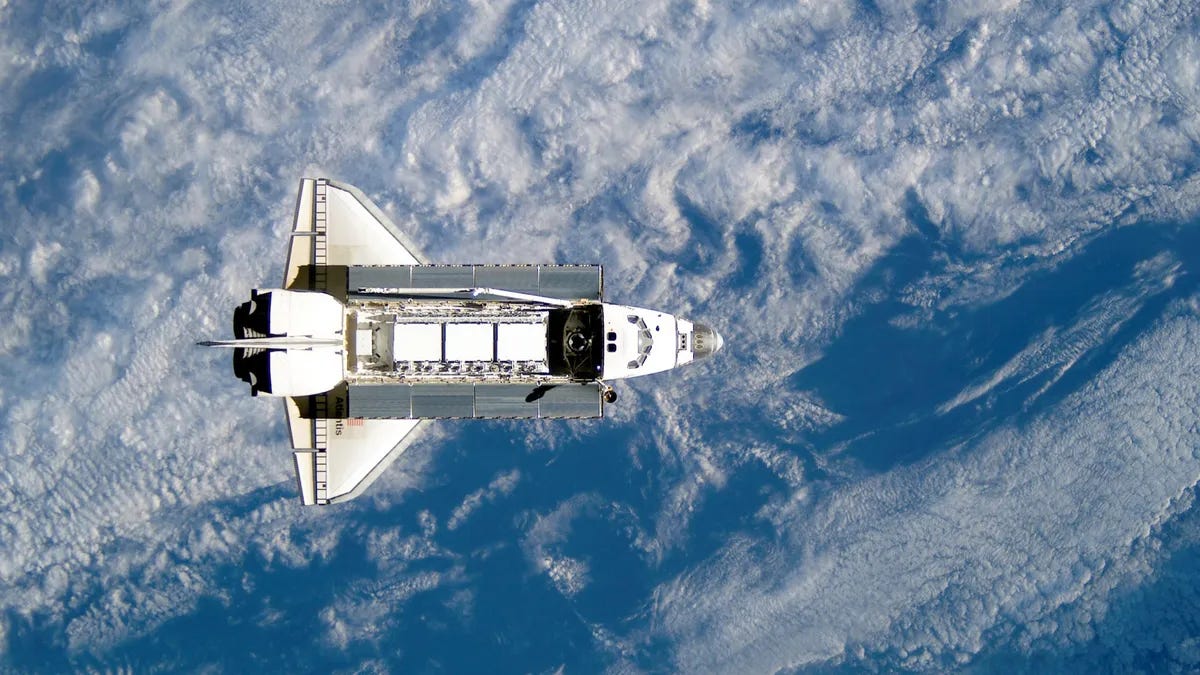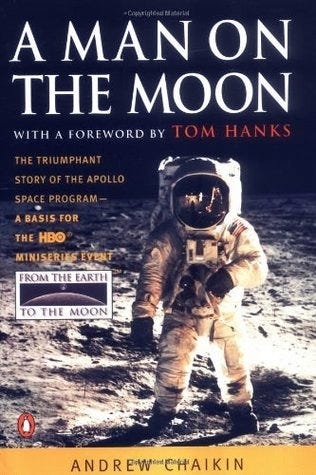
Good afternoon!
Last week, I read two books about astronauts. I started with Taylor Jenkins Reid’s new book, Atmosphere, a historical fiction book about the 1980s Space Shuttle program. I can usually rely on Taylor Jenkins Reid for a fun summer read (Daisy Jones & The Six, The Seven Husbands of Evelyn Hugo, and Carrie Soto is Back). Unfortunately, Atmosphere was deeply underwhelming, and I wouldn’t recommend it.
That said, Atmosphere got me thinking about the space race, so I picked up an older nonfiction book about the Apollo program, A Man on the Moon by Andrew Chaikin. I highly recommend this book to someone who likes narrative nonfiction or is interested in the lunar program. Let’s get into it.
read📖→
Atmosphere: A Love Story by Taylor Jenkins Reid
Atmosphere follows Joan Goodwin as she joins NASA’s Space Shuttle program in the 1980s.
Overview: Atmosphere follows two timelines. Most of the book is set in 1980 and centers on Joan’s perspective. In the summer of 1980, Joan Goodwin, a professor of physics and astronomy at Rice University, begins her training to become an astronaut at Houston’s Space Center. Joan grows close with her fellow candidates: Hank Redmond, from the Top Gun program, John Griffin, a scientist, Lydia Danes, a mission specialist, Donna Fitzgerald, and Vanessa Ford, an aeronautical engineer. Joan must navigate her own family dynamics and relationships with her sister, Barbara, and her young niece, Frances.
The second timeline is set in December 1984 and focuses on the perspective of Vanessa Ford, who is on a mission. We learn early on that there is some sort of accident in space (alarms blare, cabin pressure drops). Joan is in Mission Control in Texas and corresponds with the astronauts as they deal with a catastrophe.
As the title clearly states, there is romance, but I won’t spoil that for you.
Opinion: Atmosphere is one of the most anticipated books of the summer, but it has been one of my most underwhelming reads so far (along with Emily Henry’s Great Big Beautiful Life).
To be fair, this book is generally easy to read, and if I were on a beach, I’d probably read this in a sitting or two. The setting is fun and different for a popular historical fiction novel, and the characters have some depth/backstories. However, if you’ve read Reid’s other books, you’ll recognize these character types. Reid seems to have developed somewhat of a formula for her books, and you can see exactly where the plot is going.
Atmosphere is not literary fiction, and it’s not trying to be. I’m fine with that and didn’t expect this to be Elena Ferrante, but I thought Atmosphere was distractingly corny. The characters repeat trite things that their parents said to them as children like:
“Bravery is being unafraid of what other people are afraid of. Courage is being afraid, but strong enough to do it anyway.”
“You have to have something on the line for it to be called character.”
Maybe I’m being overly cynical, but I do like somewhat corny romance books (Bridgerton, Outlander, A Court of Thorns and Roses). Basically, I can get over lines that make my eyes roll. What I can’t get over is a dull, slow-moving plot with boring characters. The plot is quite repetitive and predictable given the exciting setting.
Part of the reason might be that most of the story is told through the wide, naive eyes of Joan. She is smart, kind, and always five minutes early. She’d “never tried a beer” until the other astronauts insisted, and “she’d been surprised to find that Coors Light was delicious.” Joan’s only faults are that she can sometimes be “grumpy and a little antisocial.” Another astronaut tells Joan that it’s a “good thing” because it gives her “some much needed dirt on your clothes . . . otherwise you’re a little too perfect . . . . A little edge to you is good.” I personally could have done with a little more edge.
I also wish Reid had included a bit more context about NASA. I didn’t learn much, and I thought most of Reid’s energy was spent telling a well-known (but not particularly nuanced) story about women, sexism, and discrimination in the 1980s. For instance, Joan is trying to show her niece that women can be anything. The female astronauts don’t get along with the women in their lives who are stay-at-home mothers/wives.
Overall: I’d skip this one. It’s not awful, but there are too many other good books out there!
Rating: 2.8/5
Genre: Historical Fiction
Page count: 352 pages
Audio: 9 hours 52 minutes
Movie/TV pairings: Gravity, Fly Me to the Moon
Man on the Moon by Andrew Chaikin
A Man on the Moon is a nonfiction book published in 1994 about the Apollo space program. The Apollo program ran from 1961 to 1972, and six of the missions landed on the moon.
Overview: A Man on the Moon opens with the tragic fire that claimed the lives of three astronauts, Virgil “Gus” Grissom, Edward H. White II, and Robert B. Chaffee, during a launchpad test at Cape Canaveral in 1967 as part of the Apollo 1 mission. It was a sobering reminder of the dangers of space travel and a setback for JFK’s goal to land a man on the moon before the end of the 1960s.
Chaikin then walks the reader through each of the Apollo missions, culminating in the last mission, Apollo 17, in 1972. The moon program’s “size and complexity dwarfed even the Manhattan Project.” More than 400,000 people worked on Project Apollo.
Following the successful landing of Neil Armstrong-led Apollo 11 on the moon in 1969, a NASA task force outlined an ambitious space program. “The task group’s timetable called for a twelve-man space station and a reusable space shuttle as early as 1975, depending on funding. By 1980 the station would have grown into a fifty-man space base; five years later there would be a hundred men in orbit. Meanwhile, there would be a base in lunar orbit by 1976, with a base on the lunar surface two years later. Then, as early as 1981, the first manned expedition to Mars would depart from earth orbit.”
Alas, none of this came to be. While there were five more moon landings after Apollo 11, the public’s interest in lunar exploration waned. As Chaikin asks, “How could the most futuristic thing humans have ever done be so far in the past? In the narrative of the space age, Apollo is a chapter that is jarringly out of sequence.”
Opinion: A Man on the Moon is an engrossing and well-researched account of the Apollo program. In his preface, Chaikin writes that the public “never really understood what had happened. TV showed us what the astronauts did on the moon, but could not transmit the immensity of the venture.” To bridge this gap, Chaikin tells the story of Apollo through the astronauts’ perspective.
Focusing on the astronauts themselves is obviously limiting, and this isn’t the book to read if you want to really wrap your head around the science and scale of the lunar project or the nature of the Cold War space race. Chaikin spends a lot of time on the astronauts’ early lives and personalities. I personally appreciated his approach, as I didn’t know a lot about this topic. Chaikin writes clearly and concisely, and I could picture these lunar modules and life in space thanks to his vivid and accessible writing style.
For me, the most interesting account in A Man on the Moon was not Apollo 11, but Apollo 13. Apollo 13 launched in 1970, but the mission was aborted after an oxygen tank exploded two days into the mission. Remarkably, the crew (James Lovell, Jack Swigert, and Frank Haise) survived after using the lunar module as a makeshift lifeboat back to Earth. The Apollo 13 mission was later dramatized in a movie starring Tom Hanks, who also wrote the foreword to a later edition of this book.
A Man on the Moon is also impressively researched. Chaikin was able to interview all of the astronauts still living. All but one of the twenty-four men who went to the moon on nine of the missions were still alive when Chaikin was researching in the early 1990s.
Overall: I’d recommend this book to anyone interested in this topic, with the caveat that it is primarily about the experience and lives of the astronauts in the Apollo project.
Rating: 3.8/5
Genre: Narrative Nonfiction
Page count: 688 pages
Audio: 23 hours
Movie/TV pairings: Apollo 13
consumed 🎬🎧🗞️→
There has been a deluge of think pieces on the effects of AI, but I thought Hua Hsu had an interesting perspective here. He asks a lot of difficult questions:
“Students who used the A.I. tutor reported higher levels of engagement and motivation and did better on a test than those who were learning from a professor. May, the Georgetown student, told me that she often has ChatGPT produce extra practice questions when she’s studying for a test. Could A.I. be here not to destroy education but to revolutionize it?”
On one hand, teaching writing seems somewhat irrelevant. “And yet has there ever been a time in human history when writing was so important to the average person? E-mails, texts, social-media posts, angry missives in comments sections, customer-service chats—let alone one’s actual work. The way we write shapes our thinking.”
“In my conversations, just as college students invariably thought of ChatGPT as merely another tool, people older than forty focused on its effects, drawing a comparison to G.P.S. and the erosion of our relationship to space. The London cabdrivers rigorously trained in ‘the knowledge’ famously developed abnormally large posterior hippocampi, the part of the brain crucial for long-term memory and spatial awareness. And yet, in the end, most people would probably rather have swifter travel than sharper memories. What is worth preserving, and what do we feel comfortable off-loading in the name of efficiency?”
cooked 🍳→








